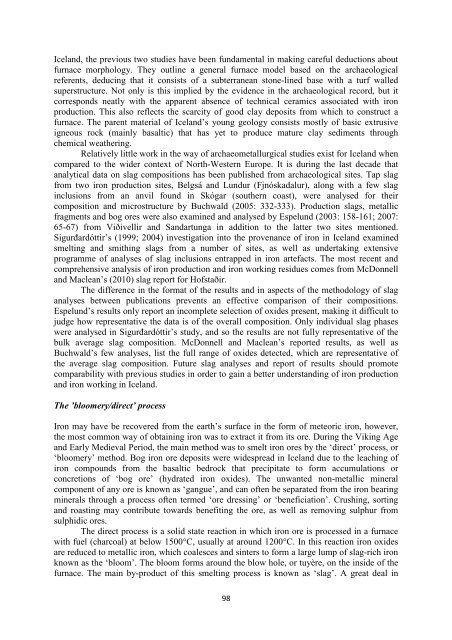Create successful ePaper yourself
Turn your PDF publications into a flip-book with our unique Google optimized e-Paper software.
Iceland, the previous two studies have been fundamental in making careful deductions about<br />
furnace morphology. They outline a general furnace model based on the archaeological<br />
referents, deducing that it consists of a subterranean stone-lined base with a turf walled<br />
superstructure. Not only is this implied by the evidence in the archaeological record, but it<br />
corresponds neatly with the apparent absence of technical ceramics associated with iron<br />
production. This also reflects the scarcity of good clay deposits from which to construct a<br />
furnace. The parent material of Iceland’s young geology consists mostly of basic extrusive<br />
igneous rock (mainly basaltic) that has yet to produce mature clay sediments through<br />
chemical weathering.<br />
Relatively little work in the way of archaeometallurgical studies exist for Iceland when<br />
compared to the wider context of North-Western Europe. It is during the last decade that<br />
analytical data on slag compositions has been published from archaeological sites. Tap slag<br />
from two iron production sites, Belgsá and Lundur (Fjnóskadalur), along with a few slag<br />
inclusions from an anvil found in Skógar (southern coast), were analysed for their<br />
composition and microstructure by Buchwald (2005: 332-333). Production slags, metallic<br />
fragments and bog ores were also examined and analysed by Espelund (2003: 158-161; 2007:<br />
65-67) from Viðivellir and Sandartunga in addition to the latter two sites mentioned.<br />
Sigurđardóttir’s (1999; 2004) investigation into the provenance of iron in Iceland examined<br />
smelting and smithing slags from a number of sites, as well as undertaking extensive<br />
programme of analyses of slag inclusions entrapped in iron artefacts. The most recent and<br />
comprehensive analysis of iron production and iron working residues comes from McDonnell<br />
and Maclean’s (<strong>2010</strong>) slag report for Hofstaðir.<br />
The difference in the format of the results and in aspects of the methodology of slag<br />
analyses between publications prevents an effective comparison of their compositions.<br />
Espelund’s results only report an incomplete selection of oxides present, making it difficult to<br />
judge how representative the data is of the overall composition. Only individual slag phases<br />
were analysed in Sigurđardóttir’s study, and so the results are not fully representative of the<br />
bulk average slag composition. McDonnell and Maclean’s reported results, as well as<br />
Buchwald’s few analyses, list the full range of oxides detected, which are representative of<br />
the average slag composition. Future slag analyses and report of results should promote<br />
comparability with previous studies in order to gain a better understanding of iron production<br />
and iron working in Iceland.<br />
The ’bloomery/direct’ process<br />
Iron may have be recovered from the earth’s surface in the form of meteoric iron, however,<br />
the most common way of obtaining iron was to extract it from its ore. During the Viking Age<br />
and Early Medieval Period, the main method was to smelt iron ores by the ‘direct’ process, or<br />
‘bloomery’ method. Bog iron ore deposits were widespread in Iceland due to the leaching of<br />
iron compounds from the basaltic bedrock that precipitate to form accumulations or<br />
concretions of ‘bog ore’ (hydrated iron oxides). The unwanted non-metallic mineral<br />
component of any ore is known as ‘gangue’, and can often be separated from the iron bearing<br />
minerals through a process often termed ‘ore dressing’ or ‘beneficiation’. Crushing, sorting<br />
and roasting may contribute towards benefiting the ore, as well as removing sulphur from<br />
sulphidic ores.<br />
The direct process is a solid state reaction in which iron ore is processed in a furnace<br />
with fuel (charcoal) at below 1500°C, usually at around 1200°C. In this reaction iron oxides<br />
are reduced to metallic iron, which coalesces and sinters to form a large lump of slag-rich iron<br />
known as the ‘bloom’. The bloom forms around the blow hole, or tuyère, on the inside of the<br />
furnace. The main by-product of this smelting process is known as ‘slag’. A great deal in<br />
98

















